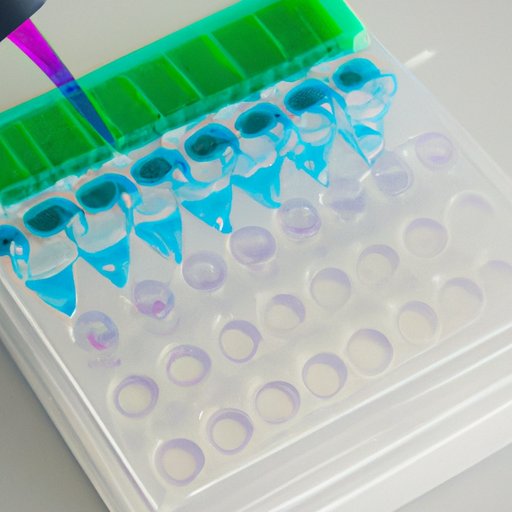Introduction
Gel electrophoresis is a technique used to separate molecules based on their size and charge. It is an essential step in many laboratory experiments, from analyzing gene expression to purifying proteins. In this article, we’ll explore the basics of how gel electrophoresis works and how it can be used to analyze DNA.
Exploring the Basics of Gel Electrophoresis
Gel electrophoresis involves the application of an electric field to move charged particles through a gel. The gel is made up of cross-linked polymers that acts as a sieve, allowing small molecules to pass through more quickly than larger molecules. By carefully controlling the strength of the electric field, the rate of migration of the molecules through the gel can be controlled.
When the electric current is applied, the molecules move towards the positive electrode. Larger molecules move more slowly than smaller molecules, so they will tend to migrate towards the negative electrode at a slower rate. By carefully controlling the strength of the electric current and the composition of the gel, it is possible to separate molecules of different sizes.
A Step-by-Step Guide to Gel Electrophoresis
Gel electrophoresis is a relatively simple process that can be broken down into four steps: preparing the gel, setting up the apparatus, running the electrophoresis, and analyzing the results.
The first step is to prepare the gel. This involves mixing together a cross-linked polymer, such as agarose or polyacrylamide, with a buffer solution. The buffer solution helps to create a stable pH environment for the molecules to migrate through.
The next step is to set up the apparatus. This involves placing the gel in a gel box and connecting it to a power supply. The power supply provides the electric current to move the molecules through the gel.
Once the apparatus is set up, the next step is to run the electrophoresis. This involves loading the sample onto the gel and turning on the power supply. The molecules will then begin to move through the gel, separating according to size.
Finally, the results can be analyzed. This involves staining the gel with a dye that binds to the molecules and makes them visible. The separated molecules can then be compared to a marker to determine their size.

How Gel Electrophoresis Can Help in DNA Analysis
Gel electrophoresis is a powerful tool for analyzing DNA. It can be used to separate nucleic acids, such as DNA and RNA, according to their size. This can be useful for determining the size of a gene or analyzing the differences between two samples.
In addition, gel electrophoresis can be used to analyze the sequence of a DNA fragment. By carefully controlling the composition of the gel, it is possible to separate DNA fragments based on their base pair sequence. This can be useful for determining the sequence of a gene or for analyzing mutations.
Understanding the Principles Behind Gel Electrophoresis
At its core, gel electrophoresis is based on two principles: charge separation and migration of molecules. Charge separation occurs when an electric field is applied to a sample containing charged molecules. The molecules move towards the electrode with opposite charge, which causes them to separate from each other.
Migration of molecules occurs when the molecules move through the gel. The gel acts like a sieve, allowing smaller molecules to pass through more quickly than larger molecules. This causes the molecules to separate according to size.
The Components and Apparatus Used in Gel Electrophoresis
Gel electrophoresis requires several components and pieces of equipment. The most important components are the gels, buffers, and power supply. Gels are cross-linked polymers that act as a sieve, allowing molecules to pass through according to their size. Buffers help to create a stable pH environment for the molecules to migrate through. Finally, the power supply provides the electric current to move the molecules through the gel.

Using Gel Electrophoresis To Separate Proteins and Nucleic Acids
Gel electrophoresis can be used to separate both proteins and nucleic acids. For proteins, SDS-PAGE (sodium dodecyl sulfate-polyacrylamide gel electrophoresis) is commonly used. This technique separates proteins based on their size and charge. For nucleic acids, Isoelectric focusing is often used. This technique separates nucleic acids based on their charge.

Comparing Different Types of Gel Electrophoresis Techniques
There are several different types of gel electrophoresis techniques. Agarose and polyacrylamide gels are the most commonly used gels for separating molecules. Agarose gels are best for separating larger molecules, while polyacrylamide gels are best for separating smaller molecules. Additionally, capillary gels are often used for high-resolution separations, while slab gels are better for large-scale separations.
Conclusion
Gel electrophoresis is a powerful tool for separating molecules based on size and charge. It can be used to analyze DNA, proteins, and other molecules, and is an essential part of many laboratory experiments. By understanding the principles behind gel electrophoresis, researchers can make use of this powerful technique to answer a variety of questions.
(Note: Is this article not meeting your expectations? Do you have knowledge or insights to share? Unlock new opportunities and expand your reach by joining our authors team. Click Registration to join us and share your expertise with our readers.)
